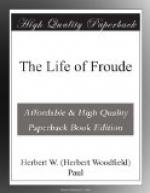Freeman’s trump card, however, was the Bishop of Lexovia, and that brilliant victory he never forgot. Froude examined the strange and startling allegation, cited by Macaulay in his introductory chapter, that during the reign of Henry viii. seventy-two thousand persons perished by the hand of the public executioner. He traced it to the Commentaries of Cardan, an astrologer, not a very trustworthy authority, who had himself heard it, he said, from “an unknown Bishop of Lexovia.” “Unknown,” observed Freeman, with biting sarcasm, “to no one who has studied the history of Julius Caesar or of Henry ii.” Froude had not been aware that Lexovia was the ancient name for the modern Lisieux, and for twenty years he was periodically reminded of the fact. Had he followed Freeman’s methods, he might have asked whether his critic really supposed that there were bishops in the time of Julius Caesar. Freeman failed to see that the point was not the modern name of Lexovia, but the number of persons put to death by Henry, on which Froude had shown the worthlessness of popular tradition.
Bishop Hooper was burnt at Gloucester in the Cathedral Close. Froude describes the scene of the execution as “an open space opposite the College.” That shows, says Freeman, that Froude did not, like Macaulay, visit the scenes of the events he described. Perhaps he did not visit Gloucester, or even Guisnes. That Freeman’s general conclusion was entirely wide of the mark a single letter from Froude to Skelton is enough to show. “I want you some day,” he wrote on the 12th of December, 1863, “to go with me to Loch Leven, and then to Stirling, Perth, and Glasgow. Before I go farther I must have a personal knowledge of Loch Leven Castle and the grounds at Langside. Also I must look at the street at Linlithgow where Murray was shot."* Thus Freeman’s amiable inference was the exact reverse of the truth.
— * Table Talk of Shirley, p. 131. —
Some of Freeman’s methods, however, were a good deal less scrupulous than this. By way of bringing home to Froude “ecclesiastical malignity of the most frantic kind,” he cited the case of Bishop Coxe. “To Hatton,” Froude wrote in his text,+ “was given also the Naboth’s vineyard of his neighbour the Bishop of Ely.” In a long note he commented upon the Bishop’s inclination to resist, and showed how the “proud prelate” was “brought to reason by means so instructive on Elizabeth’s mode of conducting business when she had not Burghley or Walsingham to keep her in order that” the whole account is given at length in the words of Lord North, whom she employed for the purpose. This letter from Lord North is extremely valuable evidence. Froude read it and transcribed it from the collection of manuscripts at Hatfield. As an idle rumour that Froude spent only one day at Hatfield obtained currency after his death, it may be convenient to mention here that the work which he did there in copying manuscripts alone




